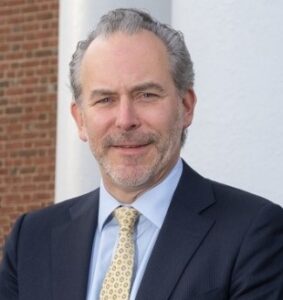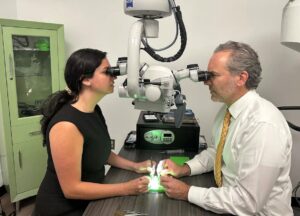Scott Hollenbeck, MD
Bio
 Dr. Scott Hollenbeck currently serves as Raymond F. Morgan Professor and Chair of the Department of Plastic Surgery, Maxillofacial and Oral Health at the University of Virginia. Dr. Hollenbeck received his MD from The Ohio State University where he graduated with magna cum laude and Alpha Omega Alpha distinction. He then completed a General Surgery residency at New York Presbyterian Hospital which also included a 2-year Vascular Surgery basic science research experience. During his residency training in 2007, he was awarded the Class of 1952 Resident Teaching Award, the Distinguished Housestaff Award, and the Compassionate Care Award. These are given by the graduating Cornell medical students, the NYPH medical center, and his department faculty, respectively. Dr. Hollenbeck’s interest in plastic surgery began during his breast surgery rotation as a PGY 3, while helping out the plastic surgery team after a mastectomy. With an established interest in both vascular surgery and surgical oncology, he found microvascular reconstruction for cancer to be his calling. In order to develop his reconstructive skills, he pursued a second residency in plastic surgery at Duke University.
Dr. Scott Hollenbeck currently serves as Raymond F. Morgan Professor and Chair of the Department of Plastic Surgery, Maxillofacial and Oral Health at the University of Virginia. Dr. Hollenbeck received his MD from The Ohio State University where he graduated with magna cum laude and Alpha Omega Alpha distinction. He then completed a General Surgery residency at New York Presbyterian Hospital which also included a 2-year Vascular Surgery basic science research experience. During his residency training in 2007, he was awarded the Class of 1952 Resident Teaching Award, the Distinguished Housestaff Award, and the Compassionate Care Award. These are given by the graduating Cornell medical students, the NYPH medical center, and his department faculty, respectively. Dr. Hollenbeck’s interest in plastic surgery began during his breast surgery rotation as a PGY 3, while helping out the plastic surgery team after a mastectomy. With an established interest in both vascular surgery and surgical oncology, he found microvascular reconstruction for cancer to be his calling. In order to develop his reconstructive skills, he pursued a second residency in plastic surgery at Duke University.
Dr. Hollenbeck started his professional career at Duke University, where he rose to Tenured Associate Professor, Division Vice-Chief, Director of Research, and Director of Breast Reconstruction. Dr. Hollenbeck also developed an interest in surgical courses and served as co-director of the Duke Flap Course and also co-developed the Oncologic Reconstruction Course. As an academic surgeon, Dr. Hollenbeck has also been involved in a number of other educational and mentoring efforts for trainees and faculty. Dr. Hollenbeck has a strong belief that Plastic Surgeons provide tremendous value to their health systems, communities and patients. His clinical practice involves both reconstructive and aesthetic plastic surgery with a specific focus on breast cancer reconstruction. He has had a successful research career in numerous areas including health services, basic science, translational and commercialization programs with well over 125 peer reviewed publications, several patents and a variety of extramural grants. Inspired by his patients and mentees, he has focused to identify barriers for accessing breast cancer reconstruction both locally and across the nation. While at Duke, Dr. Hollenbeck partnered with several Biomedical Engineers to launch a start-up company related to tissue engineering. He hopes that someday these efforts will help patients rebuild their own tissue after damaging surgeries or injuries. At the University of Virginia, Dr. Hollenbeck has now focused his laboratory efforts towards understanding diseases related adipose hypertrophy and inflammation.
As Chair of the Department of Plastic Surgery at UVA (the first Plastic Surgery Department in the country), Dr. Hollenbeck recognizes the importance of being engaged and collaborative across a large Health System and School of Medicine. “Dr. Hollenbeck’s talents as a surgeon, researcher and educator have made him a national leader in academic medicine,” said Melina R. Kibbe, MD, the dean of the School of Medicine and chief health affairs officer for UVA Health. “He is leading our excellent Department of Plastic Surgery to even greater accomplishments in service to our patients and future generations of physicians and scientists.”
In 2024, Dr. Hollenbeck was selected as the President of the American Society of Plastic Surgeons (ASPS). During his presidency, he focused on defining how plastic surgeons can be leaders within their health systems and communities, and add value to healthcare delivery in United States and beyond. Like many others, he was able to unify the specialty and organization towards this and several other critical missions.
Research
 My expertise focuses on Adipose Tissue Inflammation and Regenerative Medicine. I have training and experience in the surgical management of patients with breast cancer. My goal is to transform this clinical experience into scientific discovery. Specifically, I have developed a unique interest in the interaction between adipose tissue and a breast cancer. I am currently developing a strategy to utilize adipose cells to deliver small molecule therapeutics to breast cancer cells as well as engineered constructs. I have a broad background in scientific research, with specific focus on vascular biology and the adipose tissue response to changes within the microenvironment. As a research fellow, I was funded by an NIHT32 training grant to study the TGF-beta signaling cascade. Over the past five years, I have secured society grants to develop the background necessary for my proposed research career. My research aim originates from all my prior experiences; my clinical breast cancer care (a), my vascular biology research (b,c) and my adipocyte biology studies.
My expertise focuses on Adipose Tissue Inflammation and Regenerative Medicine. I have training and experience in the surgical management of patients with breast cancer. My goal is to transform this clinical experience into scientific discovery. Specifically, I have developed a unique interest in the interaction between adipose tissue and a breast cancer. I am currently developing a strategy to utilize adipose cells to deliver small molecule therapeutics to breast cancer cells as well as engineered constructs. I have a broad background in scientific research, with specific focus on vascular biology and the adipose tissue response to changes within the microenvironment. As a research fellow, I was funded by an NIHT32 training grant to study the TGF-beta signaling cascade. Over the past five years, I have secured society grants to develop the background necessary for my proposed research career. My research aim originates from all my prior experiences; my clinical breast cancer care (a), my vascular biology research (b,c) and my adipocyte biology studies.
Hollenbeck S, Keely P, Seewaldt V. Mammographic Density. Am Soc Clin Oncol Educ Book, 2013:63-69, 2013.
Hollenbeck, ST, Sakakibara, K, Workhu, B, Faries, PL, Liu, B and Kent, KC. Stem Cell Factor and c-kit are expressed by and may affect vascular SMCs in an autocrine pathway. J Surg Res; 102(2): 288-294, 2004. NO PMCID
Hollenbeck, ST, Itoh, H, Louie, O, Liu B, Kent, KC. Type I Collagen Synergistically Enhances PDGF Induced Smooth Muscle Cell Proliferation Through Src Dependent Crosstalk Between the a2b1 Integrin and PDGFb Receptor. Biochem Biophys Res Commun. 2004 Dec 3;325(1):328-37. Epub ahead
Hollenbeck ST, Senghaas A, Komatsu I, Zhang Y, Erdmann D, Klitzman B. Tissue engraftment of hypoxic-preconditioned adipose-derived stem cells improves flap viability. Wound Repair Regen.2012 Nov-Dec;20(6):872-8. PMID: 23110692
Hollenbeck ST, Senghaas A, Komatsu I, Zhang Y, Erdmann D, Klitzman B. Tissue engraftment of hypoxic-preconditioned adipose-derived stem cells improves flap viability. Wound Repair Regen. 2012 Nov-Dec;20(6):872-8. PMID: 23110692
Hollenbeck, ST, Nelson, PR, Yamamura, S, Faries, PL, Liu, B, Kent, KC. Intracellular Calcium Transients are necessary for platelet derived growth factor but not extracellular matrix protein induced vascular smooth muscle cell migration. J Vasc Surg. 2004 Aug;40(2):351-8. PMID:15297833
Sakakibara, K, Liu, B, Hollenbeck, ST, Kent, KC. Rapamycin inhibits fibronectin-induced migration of the human arterial smooth muscle line (E47) through the mammalian target of rapamycin (mTOR). Am J Physiol Heart Circ Physiol. 2005 Jun;288(6):H2861-8. PMID: 15708965
Tsai S, Hollenbeck ST, Ryer EJ, Edlin RS, Yamanouchi D, Wang C, Liu B, Kent KC. TGF-{beta} through Smad3 signaling stimulates vascular smooth muscle cell proliferation and neointimal formation. Am J Physiol Heart Circ Physiol. 2009 Aug;297(2):H540-9. PMCID: PMC2724222
Kundi R, Hollenbeck ST, Yamanouchi D, Herman BC, Edlin R, Ryer EJ, Wang C, Tsai S, Liu B,Kent KC. Arterial gene transfer of the TGF-{beta} signaling protein Smad3 induces adaptive remodeling following angioplasty: a role for CTGF. Cardiovasc Res. 2009 Jul 22. PMCID: PMC2761202
Breast cancer treatment. In addition to what is described above in vascular biology, I also developed an interest in the treatment of breast cancer. As a medical student, I had the opportunity to be part of one of the first studies to confirm a reduction in morbidity with the sentinel lymph node biopsy procedure (i). I also evaluated factors associated with positive surgical margins following lumpectomy (j). As part of my ongoing research collaborations, I have developed a scientific interest in the interaction between breast stromal adipose cells and a developing tumor as well as interactions with chemotherapy. These studies, and others, have allowed me to be a relevant breast cancer researcher and caregiver.
Burak WE, Hollenbeck ST, Zervos EE, Kock KL, Kemp LC, Young DC. Sentinel Lymph Node Biopsy Results in Less Postoperative Morbidity Compared with Axillary Lymph Node Dissection for Breast Cancer. Am J Surgery 2002; Jan 183(1):23-7. PMID: 11869698
Hollenbeck, ST; Cellini, C, Christos, P; Varnado-Rhodes, Y; Martins, D; Nussbaum, M; Osborne, MP, Simmons, RM. Re-excision for Positive Margins in Breast Cancer Patients; Tumor Size Assessment and Prognosis. Ann Surg Oncol. 2004 Jan;11(1):59-64. PMID: 14699035
Zeidler KR, Berkowitz RL, Chun YS, Alizadeh K, Castle J, Colwell AS, Desai AR, Evans G, Hollenbeck S, Johnson DJ, Morris D, Ascherman JA. AeroForm patient-controlled tissue expansion and saline tissue expansion for breast reconstruction: a randomized controlled trial. Ann Plast Surg. 2014 May;72 Suppl 1:S51-5.
Shammas RL, Cho EH, Glener AD, Poveromo LP, Mundy LR, Greenup RA, Blackwell KL, Hollenbeck ST. Association Between Targeted HER-2 Therapy and Breast Reconstruction Outcomes: A Propensity Score-Matched Analysis. J Am Coll Surg. 2017 Sep 26. pii: S1072-7515(17)31928-2.
